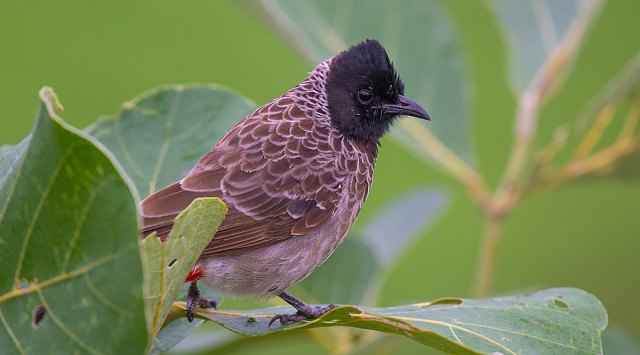Birds Without Borders: Red-vented bulbul, a finely scaled beauty loyal to its partner
Red-vented bulbuls are social birds which forage in a group, eat during the day and rest at night. Common resident birds of Gujarat, they nest all around the state.
 A red-vented bulbul moving across a Palash tree leaf at Gir forest in Gujarat. (Credits: Dr Jayendra Bhalodiya)
A red-vented bulbul moving across a Palash tree leaf at Gir forest in Gujarat. (Credits: Dr Jayendra Bhalodiya) Red-vented bulbuls (Scientific name: Pycnonotus cafer) are talkative beautiful birds known to be loyal to their partners through several mating seasons.
They are found everywhere — gardens, housing societies, forests, farms, semi-arid and dry areas. Common resident birds of Gujarat, they nest all around the state.
Their wings, neck and throat are finely scaled in brown and white, and their face is black. They have a yellowish shade on their stomach, and their beak is horn-like black. The crest gives their head a triangular shape. Their vent is red, and that’s how they got their name.
They have a white rump, and tail feathers end in a white shade. Such colours are visible during their courtship display in which they spread all their feathers of wings and slowly flutter them as if opening and closing them. Moreover, they open tail feathers while keeping them low and chirp to attract the mate. They are often noticed diving in the air during sunset.
The birds fly a little higher and drop themselves repetitively. Persian poets have written several pieces praising the melodious vocal bulbuls native to Iran.
Red-vented bulbuls exhibit monogamous mating behaviour, which means they mate with the same partner for a long time. The bird lays two-three eggs and hatches them for about two weeks.
These social birds forage in a group, eat during the day and rest at night. Their diet involves flower buds and petals, fruits, seeds and insects. It is a great pleasure to watch them eating the petals of the Palash tree (Butea monosperma). When the Palash tree is in full bloom, they feast on them.
Them eating teak seeds (Tectona grandis) and moving above teak leave is another sight to behold. Teak leaves are comparatively more significant, so the bulbul can easily hold onto and walk over them.
Red-vented bulbuls are 20 cm in size, weigh about 30-40 grams and live for approximately a decade. They live in shrubland, vegetation, gardens and near human habitation. Their nest
consists of twigs which they keep together using cobwebs and make a bowl-shaped nest.
They usually nest in shrubs. One bulbul (alternatively) from the pair protects the nest and tries to keep intruders such as prey birds away.
However, Jacobin cuckoo often mixes her eggs in the nest of red-vented bulbul. Such behaviour is scientifically referred to as brood parasitism which is very common with cuckoos; they lay their eggs in someone else’s nest. In such cases, bulbul hatches cuckoo’s eggs and feeds the young ones.
The International Union for Conservation of Nature Red List categorises red-vented bulbuls as Least Concern (LC). Their population is believed to be increasing. In the past, bulbuls were used in bird fights. Such practice was prohibited by law later.
Next time you are on an evening stroll in a garden, keep an eye out for a finely scaled brown beauty, and you will indeed find red-vented bulbuls.












